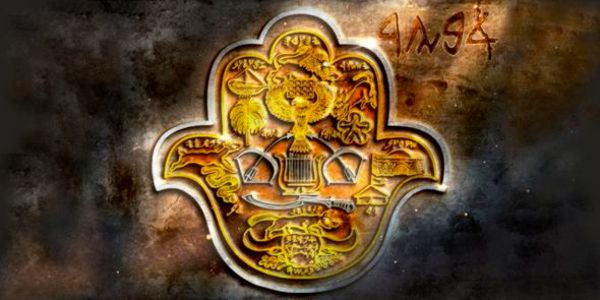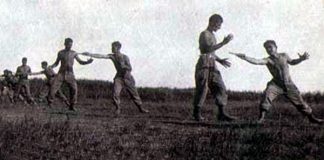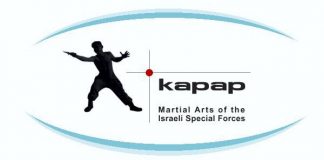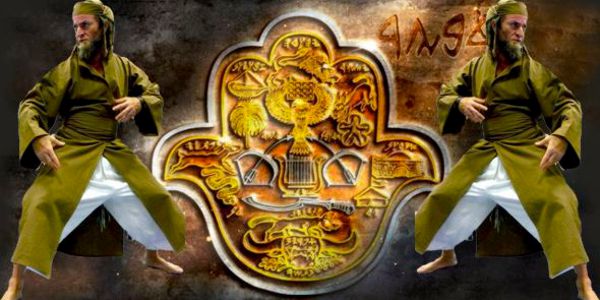 When Abir-Qesheth was first publicized on the internet there were a number of discussions concerning the validity of their claims one of which was whether or not Abir-Qesheth was a valid “martial art.” The problem that the question poses is one of terminology and what each questioner means by the statement “Martial Arts.” Because there is no scientific or universally set definition of what a martial art is, a range of definitions or declarations can be found from a strictly opinionated frame of mind. Further complicating the matter is the fact that in contrast there is also no universally accepted standard for what is not a martial art.
When Abir-Qesheth was first publicized on the internet there were a number of discussions concerning the validity of their claims one of which was whether or not Abir-Qesheth was a valid “martial art.” The problem that the question poses is one of terminology and what each questioner means by the statement “Martial Arts.” Because there is no scientific or universally set definition of what a martial art is, a range of definitions or declarations can be found from a strictly opinionated frame of mind. Further complicating the matter is the fact that in contrast there is also no universally accepted standard for what is not a martial art.
It is their position that this debate is completely unnecessary since they declare that Abir-Qesheth should not be categorized within the English term Martial Art. Below they will explain why.
According to the Wikipedia article on the subject:
“Although the term martial art has become associated with the fighting arts of eastern Asia, it was originally referred to the combat systems of Europe as early as the 1550s. The term is derived from Latin, and means “arts of Mars”, the Roman god of war. Some authors have argued that fighting arts or fighting systems would be more appropriate on the basis that many martial arts were never “martial” in the sense of being used or created by professional warriors.”
Additionally, Webster’s dictionary defines martial arts as “systems of self-defense originating in East Asia, such as karate or kung fu, also engaged in for sport” while the Online Etymology Dictionary states: “Martial arts (1909) as a collective name for the fighting sports of Japan and the surrounding region translates Japanese bujutsu (武道).”
By these “western” definitions, Abir-Qesheth would rightly so not be classified as a martial art because it did not originate in East Asia, e.g., China or Japan, and is not a part of the western concept of sport. This concept may seem strange to some but consider that there has been debate in recent history on whether or not boxing is a martial art. According to an article on the Martial Tribes web-site:
“People often ask this question as some say boxing is considered more of a sport and not a martial art for a number of reasons. One obvious reason being because boxing doesn’t have an Asian tradition that the majority of other martial arts possess. People that don’t really know much about martial arts just assume that they all come from an Asian tradition, and probably haven’t been following the current events that has developed over time.”
It is because of the above variances in consideration and debate some experts have instead chosen to categorize some systems as “Martial Arts” others as “Fighting Techniques” while another group can be solely claimed as “Self-Defense.” Each of these groups can be exclusive from the others depending on how those who train in them use them or how they self-define their practices.
The Initial Problem: Semantics or Differences in Culture / Language?
The first flaw in the question of whether or not Abir-Qesheth is a martial art rests in the before mentioned history of the statement/term “martial arts” in the English language and what it means culturally when describing the systems that are accepted as falling under its definition. The Abir-Qesheth system has always been grounded in Torah principles, one of which is the rejection of Avodah Zara, and Avodah Zara has some clearly defined by elements found in many ancient and modern human cultures/practices around the world. This Jewish rejection of Avodah Zara, based on Torath Mosheh, extends to what associations a Torah based Jew makes and even the manner of speaking that a Torah based Jew employs. Due to the origins of the term martial arts, “arts of Mars the Roman god of war,” it would be incorrect to use such a term for Abir-Qesheth.
More than 2,000 years ago the land of Israel was once occupied by the Roman Empire and Torah based Jews saw this occupation as a threat on all levels. In addition, most aspects of Roman culture were seen to be so antithetical to the Torah, and thus Avodah Zara, that even minute actions such as the method of tying one’s sandals were seen as perfect opportunities to do so differently than Romans did it. Numerous Jewish revolts broke out against the Romans to the level that historically those revolts are seen as one of six reasons the Roman Empire fell.
Some of these tensions are best expressed in the article “The Jewish Revolts Against the Roman Empire” by the “On Jewish Matters” website which states:
“The Jews’ anti-Roman feelings were seriously exacerbated during the reign of the half-crazed emperor Caligula, who in the year 39 declared himself to be a deity and ordered his statue to be set up at every temple in the Roman Empire. The Jews, alone in the empire, refused the command; they would not defile Hashem’s Temple with a statue of pagan Rome’s newest deity. When Nero became the emperor, a governor named Florus convinced him to revoke Jews’ status as citizens of the Empire. This change in their status left them unprotected should any non-Jewish citizens choose to harass them.
Further, according to the Jewish Virtual Library’s article Ancient Jewish History: The Great Revolt (66 – 70 CE):
Caligula threatened to destroy the Temple, so a delegation of Jews was sent to pacify him. To no avail. Caligula raged at them, “So you are the enemies of the gods, the only people who refuse to recognize my divinity.” Only the emperor’s sudden, violent death saved the Jews from wholesale massacre. Caligula’s action radicalized even the more moderate Jews. What assurance did they have, after all, that another Roman ruler would not arise and try to defile the Temple or destroy Judaism [Torath Mosheh] altogether? In addition, Caligula’s sudden demise might also have been interpreted as confirming the Zealots’ belief that Hashem would fight alongside the Jews if only they would have the courage to confront Rome. In the decades after Caligula’s death, Jews found their [practice of Torah] subject to periodic gross indignities, Roman soldiers exposing themselves in the Temple on one occasion, and burning a Torah scroll on another.”
Again, returning to “The Jewish Revolts Against the Roman Empire” article on the “On Jewish Matters” website:
The Great Revolt began in the year 66. It started when the Jews discovered that the Roman governor, Florus, had stolen huge amounts of silver from the Temple. The revolutionaries first attacked Jews loyal to Rome and then overpowered a Roman garrison stationed in Jerusalem, temporarily eliminating Roman control of the region. The governor of Syria, Cestius Gallus, was dispatched to restore order with thirty thousand troops. After a series of attempts he was defeated and was not able to retake Jerusalem.”
In response to these revolts, and after years of Roman invasion, eventually the Roman army was able to destroy the Beith HaMiqdash in Jerusalem. The surviving Jewish warriors were often executed, tortured, or forced to fight in Roman sponsored gladiatorial matches; in fact under Titus Jews were forced into fighting with wild beasts in public Roman arenas. Though the Romans won the war it must be noted that Jews, as a people and culture, survived while the Roman Empire eventually fell apart. I.e. they survived their losses while they [the Romans] did not survive theirs.
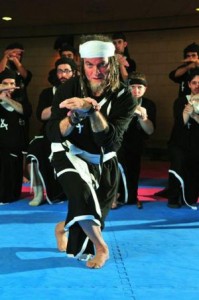
Even to this day, these events have been etched into the Torah Jew’s mindset and are not easily forgotten as the memory of their ancestor’s resistance to the Roman occupation, and all aspects of the culture that came along with it, are still to this day the basis of many Torah based cultural practices. Thus, even using a term like “martial” derived from the Romans to describe something Jewish is not in their interest.
So in this regard, the practitioners of Abir-Qesheth refuse to describe or define their mesorah based on anti-Torah based cultures. To those who are outside of the Torath Mosheh world this may seem like semantics, but to the those who hold by Torath Mosheh the following will be more than familiar.
שמוות כג : יג
ובכל אשר-אמרתי אליכם, תשמרו; ושם אלהים אחרים לא תזכירו, לא ישמע על-פיך.
משנה תורה – מצוות לא תעשה יד
שלא לישבע בעבודה זרה לעובדיה, ולא משביעין אותן בה, שנאמר “ושם אלוהים אחרים לא תזכירו” (שמות כג,יג).
משנה תורה – הלכות עבודה זרה וחוקות הגויים ה,יד [י]
הנודר בשם עבודה זרה, והנשבע בה–לוקה, שנאמר “ושם אלוהים אחרים לא תזכירו” (שמות כג,יג): אחד הנשבע בה לעצמו, ואחד הנשבע בה לגוי. ואסור להשביע לגוי ביראתו. ואפילו להזכיר שם עבודה זרה שלא דרך שבועה–אסור, שנאמר “לא תזכירו”. [יא] לא יאמר אדם לחברו, שמור לי בצד עבודה זרה פלונית וכיוצא בזה. וכל עבודה זרה הכתובה בכתבי הקודש–מותר להזכיר שמה, כגון פעור ובל ונבו וגד וכיוצא בהן. ואסור לגרום לאחרים שיידרו ושיקיימו, בשם עבודה זרה; ואינו לוקה אלא הנודר בשמה והמקיים בשמה, והוא הנשבע בשמה.
שלחן ערוך – יורה דעה
סימן קמז – שלא להשביע בשם עבודת כוכבים (של עובדי כוכבים), ודיני הזכרת שמה, א הַנּוֹדֵר אוֹ נִשְׁבָּע בְּשֵׁם עֲבוֹדַת כּוֹכָבִים, הֲרֵי זֶה (הָיָה) לוֹקֶה. וְאָסוּר לְהַזְכִּירָהּ בִּשְׁמָהּ, בֵּין לְצֹרֶךְ בֵּין שֶׁלֹּא לְצֹרֶךְ.
ראב”ע על שמות כג : יג
לא תזכירו – שלא תזכירו שמותם להישבע בהם גם שלא ישביעו בהם עובדיה. וזה ולא ישמע על פיך שתשביע בו אחרים. שלא תאמר לעובד כוכבים השבע לי באלהיך.
רשי על שמוות כג : יג
לא ישמע – מן הגוי [עובדי עבודה זרה]:
על פיך – שלא תעשה שותפות עם נוכרי וישבע לך בעבודה זרה שלו נמצאת שאתה גורם שיזכר על ידך:
הלכות עבודה זרה וחקות הגויים – ר’ אברהם בן דוד ז”ל
מניין המצוות: א) שֶׁלֹּא לִפְנוֹת אַחַר עֲבוֹדָה זָרָה – שלא יעסיק מחשבתו בהבלי עבודה זרה, מפני שהעיון בהם “מעורר את הפתי לדרוש אותם ולעבדם” (סה”מ ל”ת י; להלן ב,ב–ג). ב) שֶׁלֹּא לָתוּר אַחַר הִרְהוּר הַלֵּב וּרְאִיַּת הָעֵינַיִם – שלא לשוטט במחשבה עד שנאמין בהשקפות שהן נגד התורה, ונצטווינו “לעשות למחשבה גבול שתעמוד אצלו, והוא מצוות התורה ואזהרותיה” (סה”מ ל”ת מז; להלן ב,ג)
Further, those who have historically trained in Abir-Qesheth never used any term similar to “martial arts” to describe what they were training in and practicing. They were native Hebrew speakers and the term martial arts, and its ideology, did not exist for them and for the most part does not exist now for us today here in the modern state of Israel. Instead, our ancestors called Abir-Qesheth by names such as (כלי מלחמה), (קרבי), and (קשת) and there was never a conflict with what they were training in and how they lived their lives according to the Torah. Thus, in English “Fighting Techniques” or “Self Defense” should be used when speaking of Abir-Qesheth rather than the statement martial arts.
To further illustrate this point, in the book “Young men in Israeli Haredi yeshiva education: The scholars’ enclave in unrest,” pages 122 to 123, Dr Yohai Hakak points out the following view of Hareidi Rabbis towards the western concept of “martial arts.”
“One of the more popular fields among yeshiva students, which also arouses great opposition among rabbis, are the martial arts. Not only is this an expression of the culture of the body, but such studies demand perseverance and participation in several sessions each week—in other words, routine cancellation of Torah study. Furthermore, the development of martial skills distance the young Haredi further from the model of the self-restraining man, passive man, which is the ideal Haredi model. ‘They instruct their students to trust in [Hashem], a yeshiva rabbi explained to me. ‘If they encounter danger, only He [Hashem] can really protect them, rather than all sorts of man-made techniques’
Martial arts, especially the south east Asian ones, are particularly problematic, as they are based on local philosophies that deal with the relation of body and soul. It seems that the religious and philosophical aspect of some of them is one of the reasons for their popularity among yeshiva boys, as well as the objections to them on the part of rabbis who see them as a form of [Avodah Zara].”
Rabbi Rivid Nagar sums it up best when responding to a question about learning the fighting arts.
“יש אומנויות לחימה שונות בכל רחבי העולם, רובם קשורים בקשר ישיר או עקיף לסוג של עבודה זרה, ולכן כל מי שלומד אומנות כזו או אחרת, יעשה זאת רק לצורך הגנה עצמית מבלי להתחיל לדקלם שפות ולקוד כל מיני קידות מיותרות וכיוצב’…..הורים שחפצים שהילדים שלהם ילמדו להתגונן, אין שום בעיה שירשמו אותם לאומנות לחימה. אולם, חשוב מאוד לברר מיהו המלמד, המאמן, כי הילדים נקשרים מאד למאמן והופכים אותו לסוג של ‘מאסטר מוערץ’ ולכן כדאי מאוד למצוא מאמן ירא שמים. (יש שיטת לחימה נפלאה שנקראת ‘אביר’ שם לפחות המאמן נראה אדם ירא שמים).”
So as can be seen this is not some “semantic argument” as some have tried to paint it but instead it is one that is clear and real in the Jewish framework of life and the distinction is important to those who are Jewish, whether they keep Torath Mosheh or not. Lastly, to this point, in modern Hebrew the statement used for fighting systems (אמונות לחימה) does not directly translate into “martial arts,” see below:
- אמונות = art
- לחימה = Fighting
- הגנת = Defense/Protection
- עצמית = Self
- שיטה = Style
Fighting Techniques vs. Martial Arts
As noted in the Wikipedia article, a second flaw in the question is that many westerners think that “martial arts” are all derived from Asia, and that the more Asian it is the more authentic, ancient, and effective it is. Whether this is true for a martial arts is only something those who are a part of the martial arts community can determine. This is not the case when considering successful “fighting techniques” since true effectiveness of any fighting technique is based on the person who trains in it, their work ethic, and the circumstances surrounding each conflict.
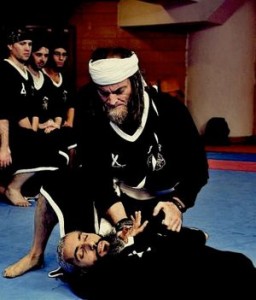
I.e. a martial artist may criticize negatively a particular set of techniques, using martial arts based criterion, yet if said person is able ot survive a physical confrontation using those techniques the martial arts critirion is not applicable. (See this video HERE for a discussion on this.) Further, attackers come in all shapes, types, and manners and many of which may happen with little or no martial arts experience thus the only critirion is “survival” when it comes to fighting techniques. By like token self-defenders come in all shapes and sizes and the skill set needed for survival is different that needed in martial arts competition.
Also, there are a number of techniques which are staples of the professional martial arts world which in a survival situation would put the average person in danger if performed. For example, a flying arm bar may be performed exactly by the book yet if used by self-defender in an attack will put said self-defender in danger of injury when their body meets the hard ground rather than a mat. Even punching an attacker with a closed fists may cause bone fractures to the hand / wrist and thus hamper their ability survive against continued attacks by single combatants or multiple attackers. There are also some techniques in martial arts spectrum that only work in a one on one fight or when the combatants are dressed in a particular way such as with uniforms or a particular type of footwear, or the lack of footwear.
In reality, since no one culture can claim to be the originator of fighting techniques and no culture has a patent on what are effective techniques of “self-defense” the only proving ground is in the cold reality that is at the control of an attacker. For example, a land owner living in Mesopotamia 3,500 years ago who successfully used physical skills or his environment to preserve his life or protect his property was obviously not a martial artist and their techniques may be strange or even comical to a martial artist who focused on the competition in the ring. By like token, said land owner may not understand the concept of a person who trains a few days a week in a modern martial arts class since such training does not serve the land owners day to day needs.
In this same view, if a community of people developed successful methods of survival in physical confrontations and members have a historical reputation as being “fierce warriors” it is completely logical that they are “fierce warriors” because they have effective fighting techniques that have been tested in their environment. Thus, if this community’s reputation as fierce warriors spans several generations this can only mean their ancestors developed successful fighting techniques and trained their children in them.

Fake Martial Arts
The definition of anything or matter is based on the preference of those who define themselves as members or practitioners since they have the authority to define what they are doing to the exclusion of those who do not practice what they do. Whether they exist as a unified community is not relevant but instead what is central is that there are groups that self-describe themselves as “martial arts” associations and have memberships from representatives who also self-define themselves as practitioners of martial arts. Using this as a baseline they can clearly state that organizations that either are currently represented in these associations or can potentially be a part of said associations have adequate credentials to be called “martial arts.”
Further, those organizations, groups, or practices that do not meet the group requirements or do not meet the standards of those who call themselves martial artists can easily be classified as not being martial arts. For example, most people do not define members of a dance troupe as martial artists – even if said dance troupe wears uniforms, has poses, and trains. Another example is how the armed forces of any country also are not defined as martial artists, even if they contain members who self-define themselves as martial artists or have martial arts training. They are correctly defined as a component of the “military.” Furthermore, a group of men who secretly come together and spar against each for their own self determined reasons are not normally defined as martial artists and what they are doing is not defined as a martial arts if they themselves don’t define it that way. The reason is because neither practice intersects with the martial arts community as a whole or as a group.
This leads into the next issues within the self-defined martial arts world. Is a martial art fake because its techniques do not work in the sanctioned ring or because it does not have a proven history of working in the environment it claims to work in? What if 50% of its practitioners fail to use it to success in the ring but 50% of its practitioners are successful using what they learned to protect themselves during a real-world life and death struggle? Can any martial art be proven to be 100% effective in all situations irrespective of who the practitioner is?
In reality, the definition of a “fake” is something that is “not true, real, or genuine.” For example, a fake Navy Seal is someone who is claiming to be or have been an official member of UDT or Navy Seals when in reality they have not undergone and passed Navy Seal training. A person cannot be a “fake” Navy Seal if they haver never claimed or alluded to being a Navy Seal. I.e. Imagine a person who has undergone military training in Israel being accused of being a Fake Navy Seal on the merit that they claimed and actually performed military service in the Israeli Defense Froces (IDF). Just as making such an accusation in such a situation would be illogical and make no sense, so does this idea apply for someone who trains in self-defense being accused of being a part of a “fake martial art.” This because a person can be a self-defender with having trained in or participating in someone clearly defined as a martial art.
Essentially, they are not claiming Abir-Qesheth to be a Martial Art by any stretch of the term since the goals and standards held in the martial arts world are not their own. As someone once stated, “It is your pastime so you get to define what it is and what it isn’t.” Thus, something that is not self-defined as a martial art can’t be a “fake martial art” when it is not defined by its practitioners as a martial art to begin with.
Successful Fighting Techniques
The next question then is, what are successful fighting techniques? Having established that no person or group owns the patent on successful fighting techniques, they can now conclude that successful fighting techniques are those which give a positive outcome to one side in a physical conflict/combat.
Within this simplified definition are the following:
- Techniques that can be easily performed within the shortest amount of time.
- Techniques that are able to be performed in a variety of situations.
- Techniques that give the practitioner the most range of options.
- Striking, ground-work, escape, risk analysis, environmental awareness, medical attention, and legal perspective.
- Techniques that can be adjusted to differing forms of conflict.
- Techniques that can be applied to enemy combatants of various sizes, shapes, and skill.
- Techniques that are transferable between armed and unarmed combat scenarios.
Any person or group of people who can lay claim to the above can be said to have successful fighting techniques. Since techniques are inanimate objects the success of said techniques relies heavily on the person who trains in said techniques one can conlcude that even if popular “opinion” is that certain techniques are ineffective one also has to answer show that 100% of the time such techniques would provide a favorable outcome for the self-defender. The question this would be – is it due to the person performing them or their skill being impossible to pull off against ALL skilled and unskilled attackers. For example, chi-attacks and death blows have no known record of being effective in any real life physical conflict where life and death are on the line.
That being said, even techniques that by popular opinion are effective mean nothing if the user:
- Is afraid to use said techniques and is not able to overcome his/her primal fears of conflict.
- Does not maximize his/her training time to compensate for the unknowns of conflict.
- Does not learn from success and failure in physical conflict.
- Performs the wrong technique for the situation at hand.
Further, it is important to note that how one trains for a “sports martial art” and how one prepares for potential life and death combat are not the same. Training for sport has one approach while life or death combat has a slightly different one. An attack which requires self-defense skill might occur in an unfamiliar place, surrounding conditions may not be on your side (slippery ground, poor lighting, bad weather, etc), your clothes may be not good for fighting, too bulky or restrictive, and confining any moves you may make.
A Difference in Perspective on MMA Competition
Having established that Abir-Qesheth is Torah based self-defense sytem, one of the arguments that is sometimes made about Abir-Qesheth is, “let’s see how this does in the MMA ring or environment.” Let’s analyze that concept for a minute and determine if a self-defender is concerned with his / her level of success in a ring environment. Yet, being Jews who hold by Torath Mosheh they would first need to determine if a Torah based Jew would ever willingly seek out that environment to test his / her self-defense skills.
In the Sefer Hamitzvoth the Rambam states the following:
ספר המצות – רמב”ם – לא תעשה המצוה המשלימה שלשים
האזהרה שהזהרנו מללכת אחרי הכופרים ומלהתנהג כמנהגם, ואפילו במלבושם וכינוסיהם במסיבותיהם. והוא אמרו: “ולא תלכו בחקת הגוי אשר אני משלח מפניכם” (ויקרא כ, כג). וכבר נכפל לאו זה באמרו: “ובחקתיהם לא תלכו” (שם יח, ג). ובא הפירוש: לא אמרתי אלא בחוקיים החקוקיים להם ולאבותיהם. ולשון ספרא: “ובחקותיהם לא תלכו” – שלא תהלכו בנימוסות שלהם, בדברים החקוקיים להם, כגון תרטיות [רב י. קאפח – מקום משחקי בני אדם] וקרקסיות [רב י. קאפח – מקום משחקי בעלי חיים] והאסתטריות [רב י. קאפח – אולמים לכנוסי שיחות הטפות וויכוחי דת ואמונה מעין “בי אבדין.”] – אלה הן מיני מסיבות שהיו מתכנסים בהם לעבודת האלילים…..כל זה לשם הרחקה מהם וגינוי לכל מנהגיהם – אפילו במלבוש.
Further, common misconception by some regarding MMA (Mixed Martial Arts) is that everything is allowed, probably stemming from the early days of MMA as well as the other more unregulated sports in the world of martial arts. This is however false.
The Unified Rules of MMA include among other things:
- No strikes to the back of the head
- No small-joint manipulations
- No groin strikes
- No hair pulling, head butting or inserting a finger or fingers in the mouth and pulling,
- No kicks to the head of a downed opponent
- A competitor may admit defeat and stop the match by “tapping” on the opponent’s body or mat or by making a verbal announcement
- Time determined rounds
- Weight classes
- No weapons
The ultimate goal(s) of competitive MMA and other sports martial arts are understandably not a reflection of the methods of those who practice Torah based self-defense. Thus, non-Torah based instructors in these styles of martial arts do not teach Torah and Halakha as a part of their syllabus where Torah and Halakha are “the” central elements of Abir-Qesheth training because they are the central pillars in the lives of Am Yisrael. (I.e. a Jew who hold by Torath Mosheh is required to use Torah and Halakha and these would have to be in the syllabus.) This is not a criticism of the MMA or Martial Arts but instead is simply a statement of the reality. Thus, the better statement is, “Are Abir-Qesheth practitioners able to take the skills they receive from training to a) avoid conflict, b) survive conflict, c) overcome conflict, or d) in the right frame of Torah based mindset deal with potential loss in a conflict?”
Further, most of the judgments on-line about what is considered a real martial art and a fake one is decided by personal opinions on how “particular practitioners” are able to perform it within the MMA competitive format and not whether or not students not involved in that environment are able to avoid or survive physical conflicts and safely return home to their families outside of the MMA competitive format. In reality, a judgement of what is in-effective is normally based on a complete assessment of a system, from top to bottom, where the point of criticism is a lack of critical elements needed to survive conflict. For example, a system that is all wrestling with no striking, a system that is all striking with no wrestling, a system that is all joint locks with no striking or wrestling, and worst of all a system that has no pressure testing/endurance training.
Also, taking into account that all on-line promotion videos for any particular martial art are staged in order to show-case perceived strengths of certain elements of the system, no different than on-line self-defense videos, one can’t judge a video as the representation of what is possible in said system. This of course excludes the more “mythical” systems that claim magical death blows, use of chi, or any other method that has no historical proven success rate.
Just as the “training methods” and goals set in numerous military fighting systems are not used in a sports ring/square, by like token Abir-Qesheth is not for use in such a “sport” orientated environment. Not because Abir-Qesheth techniques are naturally more lethal but instead because of the goals a Torah based Jew who trains in Abir-Qesheth and the end results they are looking to achieve, are completely different than that of those found in sports martial arts.
A good example of this can be seen in numerous videos where people who practice any of the more popular MMA styles and how more than naught they fail to survive in military courses that test physical conflicts that are outside of their area of training; especially when they are set in the type environments commonly faced in the campaigns of war. This is not because those who train in MMA are not skilled or that they are not amazing athletes. Quite the opposite, a professional martial arts fighter has many of the relevant skills yet, it simply means that their training is focused in an area that a soldier would not limit himself to and the common person may never face. I.e. a professional fighter is most at home in the ring but a soldier or a self-defender most often is not “at home” and by circumstance must use all available resources to survive including objects in the environment to survive or from the start avoiding the conflict.
A real-world test of the self-defense mindset and techniques that the self-defender trains in is simulations that match what happens in the real world. I.e. weaponized attacks, chemical attacks, multiple attackers, vehical attacks, IED’s, etc. This means that the self-defender, after learning basic techniques and strategies, performs pressure testing against as many of the possibilities that can happen in life. Thus, the ring is not the proving ground for self-defense since it lacks the lack of parameters that take place in the real-world. Further, a self-defender must learn to perform, to defend themselves or others, with all of their current personal limitations and advantages.
As Rik Andino, Former Sgt US Marine Corps. Recruiter Liaison NCO, DOD Administration Management once stated when asked how effective military combat training is for fighting?
“Combat training is so that you can be effective in combat and warfare. You are most effective in combat is through superior fire power. Sure military members do practice some hand to hand combat, usually for morning PT. However most combat training is learning weapons systems and shooting rifles and firing rockets and machine guns and launching grenades. Plotting fields of fire and setting up ambushes and defensive positions, etc… And yes if you bring a grenade launcher to the Octagon you will most likely win that fight. So yes to answer your question Combat Training will make you a better fighter. Remember that bullets pack more power than punches.”
For example, learning how to inflict physical damage on someone within a set group of parameters until they either give up or are counted out combined with breaks in the action is not the same as training for a situation where there are no parameters and no breaks. When there are no parameters every object in close range can be a potential weapon with no concern for the safety of the opponent. Further, when there are no parameters an attacker or a potential victim may have already arrived at the location of conflict with weapons or associates who are ready to assist at a moment’s notice. The only concern in this scenario is escaping the conflict, preventing the opponent from further attack, and the legal ramifications of the conflict.
This may mean applying joint locks in areas of the body off limits in competition and letting go until the attacker is completely out of the fight for good. This may mean a wide range of acts associated with the concepts of “fight or flight” i.e. fighting as a tool to survive or escape the conflict. It may mean knowing how to verbally diffuse escalation or even facing multiple armed opponents. It may mean knowing how to handle child-soldiers or having the know how to respond/react to being stabbed or shot. It is also a must to know the laws of the location where a conflict is taking place because every strike, lock, or tactic may implicate one in court. It may be being prepared with some type of weapon or distance multiplier. Worst of all, this may mean ending a life or worse being spiritually in tune with one’s life if the attacker is successful.
It is for the above reasons, with all due respect to the martial arts community, that they state that instead of labeling Abir-Qesheth by the term “martial art(s)” Abir-Qesheth should be correctly categorized as:
- (תכסיסי מלחמה)
- (כלי מלחמה)
- (קרבי)
- (קשת)
or in English – “Torah based fighting techniques / self defense of Am Yisrael.”
Questions and Answers About Abir Qesheth
he following Q&A was created to respond to both actual questions and challenges to what is often found in English sites on the internet about Abir Qesheth. Some answers are directed to specific individuals and others are more general in nature.
Note: The more detailed information about Abir can be found on our Hebrew site HERE.
-
Question: Why haven’t I heard of other Jewish communities with a connection to fighting techniques?
-
Question: Is there any other comments you may have about those who talk bad about Abir Qesheth?
-
Question: Does a person have follow to Torath Mosheh/Judaism in order to train in Abir?
-
Question: I don’t live in Israel. Is there a chance that Abir can be taught outside of Israel?
This information came from the Abir-Qesheth website.

